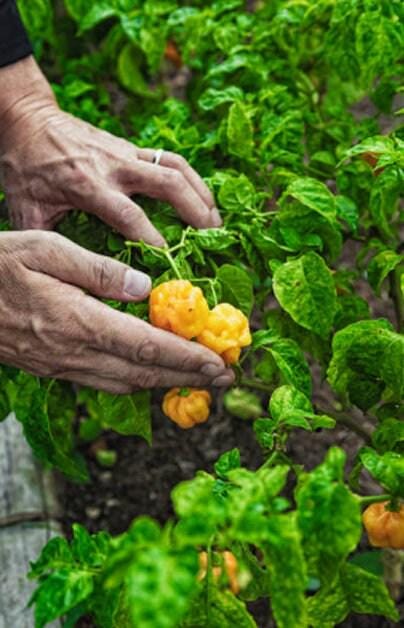This pepper gives Jamaican chicken dishes their special flavor! The crumpled pods of this fiery pepper ripen from green to a bright zesty citrus yellow, making a most attractive plant. With a hot, lemony flavour, they certainly pack a punch 350,000 Scoville Heat units. Great for containers!
Jamaican Hot Yellow is closely related to the habanero, but with a sweeter flavor and stouter shape. Peppers grow prolifically on compact plants that are about 2' tall, with a spread of 18". Matures from dark green to bright yellow. The fruits are perfect for drying or making hot Caribbean sauces. The lantern shaped peppers are 1-1/2" wide and 1-1/2" long. 90-100 days.
Jamaican Yellow Mushroom chile peppers are botanically a part of the Capsicum genus and are uniquely shaped, fiery pods that belong to the Solanaceae or nightshade family. There is some confusion as to the scientific nomenclature for Jamaican Yellow Mushroom chile peppers, as select experts classify it as Capsicum annuum while other experts label it Capsicum chinense. Despite its debated classification, Jamaican Yellow Mushroom chile peppers are a very spicy variety, ranging 200,000 - 325,000 SHU on the Scoville scale, which is comparable to the habanero pepper. Also known as Yellow Squash, Jamaican Hot Yellow, Scotch Bonnet Yellow, Jamaican Hot, Martinique Pepper and Bahama Mama. Jamaican Yellow Mushroom chile peppers earned their common name from their flat shape, similar to the cap of a button mushroom or pattypan squash. Jamaican Yellow Mushroom chile peppers are primarily used to flavor hot sauces in the Caribbean.
The official heat scale for chillies is known as the Scoville scale, developed by Wilbur Scoville in 1912.To give you an idea of the range of heat in an habanero: a sweet pepper scores 0 on the scale, jalapeño and chipotle chillies score anything between 2,500 to 10,000 and habaneros score 200,000 to 300,000!
~ planting ~
Capsiucum chinense strains require a great deal of attention during the germination process. Moisture and a constant and consistent heat range must be maintained. Start early indoors and transplant well after last frost. Lower temperatures permanently reduce plant productivity.
Start indoors in March. Place the seeds in sterile media and cover 1/4” deep. Provide 85°F bottom heat to accelerate germination, bright light and keep moist at all times. Keep soil as warm as possible. The seed is slow to germinate (up to 3 weeks).
Transplant seedlings into 3" pots and grow until there are 6 true leaves on the plant. For greatest possible flower set, try to keep them for 4 weeks at night, about 61-64°F and day time temps of 64-75°F. Plant them directly into rich soil, 30” apart or into containers.
~ growing ~
Feed and water pepper plants regularly throughout the growing season to prevent the flower buds from dropping. Provide a thick mulch of organic matter around the base of the plants to help conserve moisture and reduce weed growth. In greenhouses, maintain high humidity by damping down paths daily.
Soil should have abundant phosphorus and calcium, so add lime and compost to the bed at least three weeks prior to transplanting. Mix ½ cup of complete organic fertilizer beneath each plant. Though peppers will tolerate dry soil, they will only make good growth if kept moist. Harden off before planting out in June, 30-60cm (12-24″) apart. Water in with kelp-based fertilizer. Using plastic mulch with a cloche can increase the temperature few degrees.
~ harvesting ~
When harvesting, take care to avoid touching the interior of any broken peppers, as the capsaicin is an extreme irritant, especially to the eyes. Wash hands thoroughly after harvesting, or wear gloves to harvest peppers. Harvesting hot peppers is basically a matter of personal preference. Generally, the longer the peppers mature on the vine, the hotter they will taste. Mature peppers, however, signal the plant to stop producing; if the peppers are picked when still at the green stage, the plant will go on producing. Always use a knife or scissors to remove peppers to prevent damage to the fragile stems.
Harvest peppers singly by cutting them from the plant by with pruning clippers or pull the entire plant when full of ripe peppers, and hang upside down in the kitchen for use all year long. Peppers grown outdoors must be harvested before the first frosts.



















